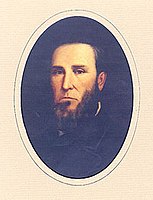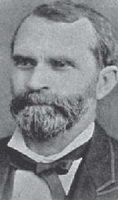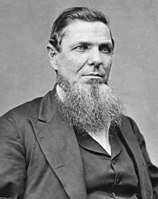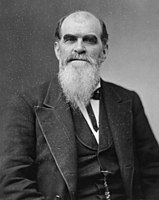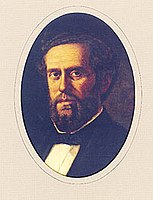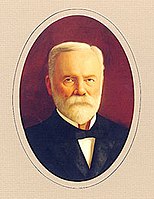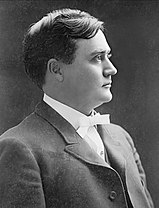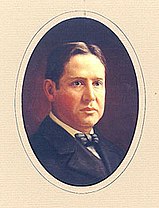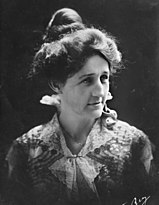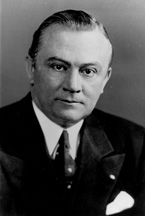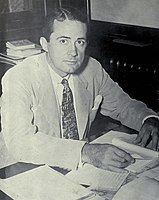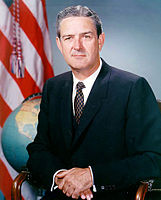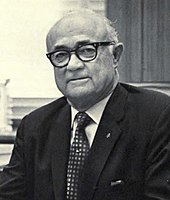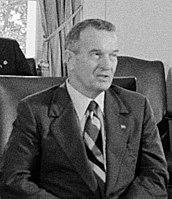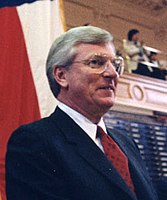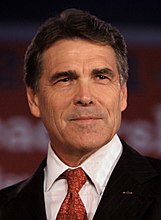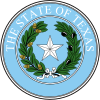It has been requested that the title of this article be changed to List of governors of Texas . Please see the relevant discussion on the discussion page. The page should not be moved unless the discussion is closed; summarizing the consensus achieved in support of the move. |
| Governor of Texas | |
|---|---|
 Gubernatorial seal | |
 Gubernatorial standard | |
| Style |
|
| Residence | Texas Governor's Mansion |
| Term length | Four years, no term limit |
| Inaugural holder | James Pinckney Henderson 1846 |
| Formation | Texas Constitution |
| Salary | $150,000 (2013) [1] |
| Website | Official website |
The Governor of Texas is the chief executive of the U.S. State of Texas, the presiding officer over the executive branch of the Government of Texas, and the commander-in-chief of the Texas National Guard, the state's militia. The governor has the power to consider bills passed by the Texas Legislature, by signing them into law, or vetoing them, and in bills relating to appropriations, the power of a line-item veto. He may convene the legislature, and grant pardons and reprieves, [2] except in cases of impeachment, and upon the permission of the legislature, in cases of treason. The State provides an official residence, the Governor's Mansion in Austin. The incumbent, Greg Abbott, is the forty-eighth governor to serve in the office since Texas' statehood in 1845.

Texas is the second largest state in the United States by both area and population. Geographically located in the South Central region of the country, Texas shares borders with the U.S. states of Louisiana to the east, Arkansas to the northeast, Oklahoma to the north, New Mexico to the west, and the Mexican states of Chihuahua, Coahuila, Nuevo León, and Tamaulipas to the southwest, while the Gulf of Mexico is to the southeast.
The government of Texas operates under the Constitution of Texas and consists of a unitary democratic state government operating under a presidential system that uses the Dillon Rule, as well as governments at the county and municipal levels.

A commander-in-chief, sometimes also called supreme commander, is the person that exercises supreme command and control over an armed forces or a military branch. As a technical term, it refers to military competencies that reside in a country's executive leadership – a head of state or a head of government.
Contents
- Governors of Spanish Texas
- Governors of Mexican Texas
- Presidents of the Republic of Texas
- Governors of Texas
- Other high offices held
- Living former governors of Texas
- Gubernatorial trivia
- Background
- Elections
- Texas governors in popular culture
- See also
- Notes
- References
When compared to those of other states, the Governorship of Texas has been described as one of relative weakness. [3] [4] In some respects, it is the Lieutenant Governor of Texas, who presides over the Texas Senate, who possesses greater influence to exercise their prerogatives. [3] [4]

The Lieutenant Governor of Texas is the second-highest executive office in the government of Texas, a state in the U.S. It is the second most powerful post in Texas government because its occupant controls the work of the Texas Senate and controls the budgeting process as a leader of the Legislative Budget Board.

The Texas Senate is the upper house of the Texas State Legislature. There are 31 members of the Senate, representing single-member districts across the U.S. state of Texas, with populations of approximately 806,000 per constituency, based on the 2010 U.S. Census. There are no term limits, and each term is four years long. Elections are held in even-numbered years on the first Tuesday after the first Monday in November. In elections in years ending in 2, all seats are up for election. Half of the senators will serve a two-year term, based on a drawing; the other half will fill regular four-year terms. In the case of the latter, they or their successors will be up for two-year terms in the next year that ends in 0. As such, in other elections, about half of the Texas Senate is on the ballot. The Senate meets at the Texas State Capitol in Austin. The Republicans currently control the chamber, which is made up of 19 Republicans and 12 Democrats.
The governor is inaugurated on the third Tuesday of January every four years along with the Lieutenant Governor, and serves a term of four years. Prior to the present laws, in 1845, the state's first constitution established the office of governor, serving a term of two years, but no more than four years of every six. [5] The 1861 constitution, following secession from the Union, established the first Monday of November following election as the term's start. [6] Following the end of the American Civil War, the 1866 constitution increased term length to four years, limiting overall service to no more than eight years of every twelve, moving the term's start to the first Thursday following organization of the legislature, or "as soon thereafter as practicable." [7] The constitution of 1869, enacted during Reconstruction, removed term limitations, [8] to this day making Texas one of fourteen states [9] with no limit on gubernatorial terms. The present constitution of 1876 returned terms to two years, [10] but a 1972 amendment again returned them to four. [11]
In the context of the United States, secession primarily refers to the voluntary withdrawal of one or more states from the Union that constitutes the United States; but may loosely refer to leaving a state or territory to form a separate territory or new state, or to the severing of an area from a city or county within a state.

The American Civil War was a civil war fought in the United States from 1861 to 1865, between the North and the South. The most studied and written about episode in U.S. history, the Civil War began primarily as a result of the long-standing controversy over the enslavement of black people. War broke out in April 1861 when secessionist forces attacked Fort Sumter in South Carolina shortly after Abraham Lincoln had been inaugurated as the President of the United States. The loyalists of the Union in the North proclaimed support for the Constitution. They faced secessionists of the Confederate States in the South, who advocated for states' rights to uphold slavery.
A term limit is a legal restriction that limits the number of terms an officeholder may serve in a particular elected office. When term limits are found in presidential and semi-presidential systems they act as a method of curbing the potential for monopoly, where a leader effectively becomes "president for life". This is intended to protect a democracy from becoming a de facto dictatorship. Sometimes, there is an absolute or lifetime limit on the number of terms an officeholder may serve; sometimes, the restrictions are merely on the number of consecutive terms he or she may serve.
Since its establishment, only one man has served in excess of eight years as governor: Rick Perry. Perry, the longest-serving governor in state history, assumed the governorship in 2000 upon the exit of George W. Bush, who resigned to take office as the 43rd President of the United States. Perry was re-elected in 2002, 2006, and 2010 serving for 14 years before choosing to retire in 2014.

James Richard "Rick" Perry is an American politician who is the 14th and current United States Secretary of Energy, serving in the Cabinet of Donald Trump. Prior to his cabinet position, Perry served as the 47th Governor of Texas from December 2000 to January 2015. Before being the 47th Governor of Texas, Perry was elected Lieutenant Governor of Texas in 1998 and assumed the governorship in December 2000 when Governor George W. Bush resigned to become president. Perry was the longest-serving governor in Texas history.

George Walker Bush is an American politician and businessman who served as the 43rd president of the United States from 2001 to 2009. He had previously served as the 46th governor of Texas from 1995 to 2000.

The president of the United States (POTUS) is the head of state and head of government of the United States of America. The president directs the executive branch of the federal government and is the commander-in-chief of the United States Armed Forces.
Allan Shivers assumed the governorship upon the death of Beauford Jester in July 1949 and was re-elected in 1950, 1952 and 1954, serving for 7 1/2 years, making him the second longest serving Texas governor. Price Daniel was elected to the governorship in 1956 and re-elected in 1958 and 1960 before losing his re-election for an unprecedented fourth term in the 1962 Democratic primary, missing the runoff. John Connally was elected in 1962 and re-elected in 1964 and 1966 before leaving office on January 21, 1969.

Robert Allan Shivers was an American politician who served as the 37th Governor of Texas. Shivers was a leader of the Texas Democratic Party during the turbulent 1940s and 1950s, and also developed the lieutenant governor's post into an extremely powerful perch in state government.

Marion Price Daniel Sr., was a Democratic U.S. Senator and the 38th Governor of the state of Texas. He was appointed by President Lyndon B. Johnson to be a member of the National Security Council, Director of the Office of Emergency Preparedness, and Assistant to the President for Federal-State Relations. Daniel also served as Associate Justice of the Texas Supreme Court.

John Bowden Connally Jr. was an American politician. He served as the 39th Governor of Texas and as the 61st United States Secretary of the Treasury. He began his career as a Democrat but switched to Republican in 1973.
In the case of a vacancy in the office, the lieutenant governor becomes governor. [12] Prior to a 1999 amendment, the lieutenant governor only acted as governor until the expiration of the term to which he succeeded. [13] [14]




